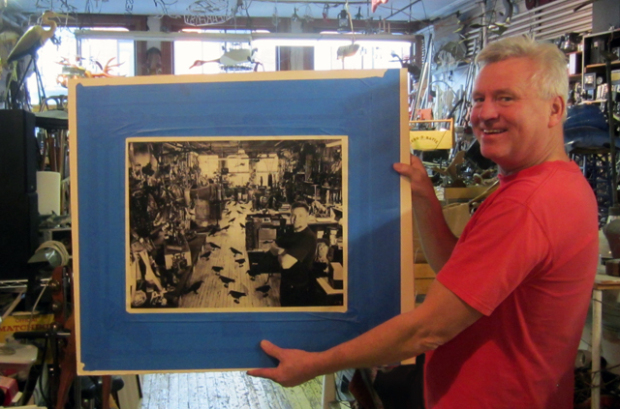

Makers are everywhere. If you’re not careful you may just bump into one. At least that’s what happened to me when I met artist Steve Gerberich as he stood on the sidewalk below his Brooklyn studio photographing one of his famous storefront window displays.
I’d noticed his hypnotic, kinetic displays in other storefronts around the neighborhood, and their distinctive DIY aesthetic had piqued my interest, so I was eager to ask about them when I ran into him on the street. Luckily, like many other makers, Gerberich was happy to oblige my curiosity and invited me to his studio where he showed me his fantastic collection of cultural artifacts and the imaginative works he’s made from them, some of which can be seen in the video below.
It’s fascinating to see Gerberich’s work in person, not just because of the idiosyncratic scenes he depicts, but because it’s nearly impossible to avoid being drawn in by the details of the myriad materials he uses and the ingenious way he uses them. Many of his kinetic works are also interactive, which makes them even more captivating as you push a button or turn a crank to see them spring into action!
Seeing his massive studio is a totally overwhelming experience because it is absolutely brimming with found objects, which are packed in all around his numerous works. It’s hard to imagine how one man could amass such an impressive stockpile of materials and sculptures, so I set about asking Gerberich how it all began.

Andrew Salomone: How did you get started making this kind of work?
Steve Gerberich: In 1985, with a University of Northern Iowa photography degree in my pocket, I moved to New York City. I was planning to stay for one year, considering it my graduate school. That was 30 years ago. The vivid images I’d been refining for making photographic installations quickly morphed into window installations. Items that had previously been happy to live within my viewfinder now enjoyed more expanded environs, such as SoHo storefronts. They now demanded motion, so I taught myself the skills needed to create a series of mechanical systems, which brought my art to life.
AS: Do you have a process for turning the objects you find into sculptural works?
SG: Works are created from collecting parts for a commissioned theme, or evolve from the objects themselves.

AS: What electronic components do you usually use?
SG: Most of my electronic components are already made. I rely on the dark room timer, Time-O-Lite to run my installations. They carry a lot of amperage, and run each work for up to one minute. I like the interaction of the viewer being able to switch on one of my machines. It allows a cause/effect, action/reaction performance.

AS: Have you ever found something that you couldn’t bring yourself to turn into a sculpture?
SG: The most difficult object I had to deal with was transforming my personal trombone into an orchestra member. Drilling that first hole to attach a bolt and pulley was quite painful.

AS: Do you have a favorite tool in your studio?
SG: Yes, I like the blue-handled channel lock, electrical side cutters. It is gratifying to hear that “snap” after it cleanly clips a wire, zip tie, or piece of rope.

AS: Do you have a favorite work?
SG: I really don’t. Most viewers react most to “The Flying Geese” or “The Gerberich Grand Orchestra.”

To see more of Gerberich’s work and find out what else he has in store, be sure to take a gander at his website!
ADVERTISEMENT





